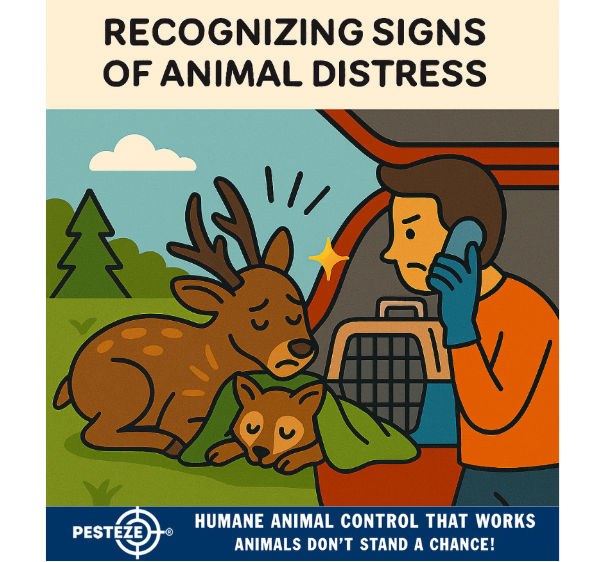RECOGNIZING SIGNS OF ANIMAL DISTRESS

RECOGNIZING SIGNS OF ANIMAL DISTRESS
SUMMARY
Animals in distress may be injured, sick, frightened, or disoriented—and recognizing these signs early can save lives. Whether you're observing wildlife, caring for pets, or encountering stray animals, understanding behavioral and physical cues is essential. This guide outlines how to identify distress in animals and respond appropriately. With compassion and awareness, you can help prevent suffering and ensure animals receive the care they need.
FEATURES
-
Unusual Behavior Patterns: Spot erratic movement, vocalizations, or withdrawal from normal activity.
-
Visible Injuries or Illness: Identify wounds, limping, swelling, or signs of infection.
-
Changes in Eating or Drinking: Recognize appetite loss or excessive thirst as red flags.
-
Isolation or Abandonment: Understand when solitude may signal distress, especially in young animals.
-
Signs of Fear or Panic: Observe trembling, pacing, or attempts to flee from perceived threats.
-
Lethargy or Unresponsiveness: Detect when an animal is unusually still, slow, or non-reactive.
GUIDE DESCRIPTION
Recognizing animal distress is a vital skill for anyone who interacts with pets, wildlife, or farm animals. Distress can stem from injury, illness, fear, or environmental stressors, and early detection often leads to better outcomes. This guide helps you identify key signs and take appropriate action.
Start by observing behavior. Animals in distress may act out of character—pacing, hiding, vocalizing excessively, or showing aggression. These behaviors often indicate pain, fear, or confusion. For example, a normally social dog that suddenly isolates itself may be experiencing discomfort or anxiety.
Physical signs are equally important. Look for visible injuries such as bleeding, limping, or swelling. Discharge from eyes, nose, or wounds may suggest infection. Matted fur, labored breathing, or unusual posture can also signal health issues.
Changes in eating or drinking habits are common indicators. A pet that refuses food or drinks excessively may be suffering from internal distress. In wildlife, emaciation or dehydration can be signs of illness or habitat disruption.
Young animals found alone may be orphaned or abandoned. While some species leave their young temporarily, prolonged isolation—especially with signs of weakness or vocal distress—warrants intervention.
Fear-based distress often presents as trembling, wide eyes, or frantic escape attempts. Loud noises, unfamiliar environments, or human presence can trigger panic in both domestic and wild animals.
Lethargy is another warning sign. An animal that is unusually still, slow to respond, or appears dazed may be in shock or suffering from a serious condition.
If you suspect an animal is in distress, contact a veterinarian, wildlife rehabilitator, or local animal control. Avoid direct handling unless necessary, and always prioritize safety—for both you and the animal.
- Amy Chang


Comments 0